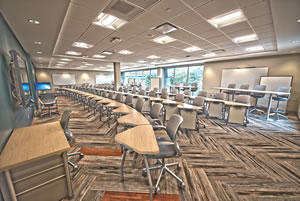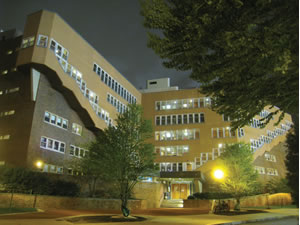Tackling a Lighting Retrofit: Ten Tips for Success
 When it comes to cost-effective ways
to reduce energy use, it’s hard to top a lighting retrofit.
Combining advances in LED fixture technology
with the use of sophisticated controls, such a move can bring
new levels of efficiency to any institution.
When it comes to cost-effective ways
to reduce energy use, it’s hard to top a lighting retrofit.
Combining advances in LED fixture technology
with the use of sophisticated controls, such a move can bring
new levels of efficiency to any institution.
“Lighting retrofits are one of the most cost-effective sustainability
projects a college or university can undertake,” says
Danielle Marquis, director of strategy at AM Conservation Group.
She says that by replacing inefficient fluorescent or High Intensity
Discharge (HID) lighting with LEDs and adding motion sensors
or photocells, campuses can improve light quality, enhance safety,
save energy and reduce costs.
“Both interior and exterior LED fixtures have decreased in
cost in recent years, making the payback period very attractive,”
Marquis says. “The projects can be completed relatively quickly,
often during school breaks or in off hours to reduce or eliminate
the impact on instructional time.”
Campus professionals and company reps alike can attest to
the potential benefits of a lighting retrofit. For those considering a
move in this direction, here are ten expert opinions on making a
successful transition.
1. Keep things simple. “In today’s LED world, where every fixture
comes with native dimming, it can be tempting to design an
overly complicated control system into a project. But the age-old
saying of ‘keep it simple’ still applies. The trick to utilizing the
latest technology for lighting control systems is to keep the light
switch intact. When occupants enter a room, they should have to
turn the lights on; hopefully this will train them to turn the lights
off once they exit, but with technology we can turn the lights off
should they ‘forget.’”
— David Rabold, capital projects manager,
Muhlenberg College, Allentown, PA
2. Blitz it. “We plan to perform an LED
lighting retrofit blitz on campus this summer.
This will include installing LED lights in approximately
85 percent of campus buildings
with installation of the remaining lights over
the next three years. Facilities Management
and specifically the electricians in the department
are fully on board with the movement
to LED lights. In addition to reducing energy
consumption and carbon emissions, they last
much longer than other bulbs, and therefore
reduce maintenance time and improve
safety, since less bulb replacement equals
less ladder time. Plans also include making
all outside lights LED, which is considered a
major improvement as they burn an average
of 12 hours a day annually.”
— Ken Shultes,
associate vice president for sustainability & facilities planning, Dickinson College,
Carlisle, PA
3. Consider wireless. “In recent years,
wireless control functionality has significantly
improved, while costs for this
technology have decreased. Keep in mind
this can also be beneficial in controlling
lighting for various classrooms to adjust to
each professor’s timely needs. Advanced
controls have also improved in their ability
to communicate between both interior and
exterior lighting; they can even integrate
into existing HVAC or BAS controls.”
—
Scott Tapia, sales manager, electrical& lighting, ABM
4. Sing a new tune. “The ability to tune
color temperature of the light is one of
the most significant advances in lighting.
Research indicates that changing the color
temperature based on the activity or task at
hand can positively impact mood, behavior
and concentration. A class with intensive
laboratory-style learning may benefit more
from a different color temperature than a
class focusing more on reading or independent
studies. With the advancements of LED
technology and the easy-to-use controls
platforms, every campus can now benefit
from tunable white lighting.”
— Mark
Kelly, president, Able Services
5. Avoid wasting time. “While technology
continues to evolve and prices continue to
drop, waiting to upgrade from inefficient
fluorescent or HID lighting is often more
costly in the long run. LEDs now allow
for longer-lasting fixture output, in some
cases over 100,000 hours. Linear retrofit
kits that are typically used for metal halides
(bright lights best used for parking lots and
stadiums) use a lower wattage with the same
lumens (brightness). This technology gives
you more lumens per watt at a lower cost.”
—
Danielle Marquis, director of strategy, AM
Conservation Group
6. Think security and more. “Indoor
and outdoor spaces should be well lit
with good wayfinding for students, staff,
educators and visitors. Safety and security
are paramount and can affect not only
individual well-being, but also recruitment
for the school. Education facilities have a
broad range of programs with many being
held outside of the traditional academic
year, which should be considered in a space
utilization and lighting design audit. While
energy efficiency and sustainability are
obvious goals for an audit, the programming
and scheduling of all buildings must
be considered when evaluating the lighting
design requirements. This approach will
certainly lead to energy-saving improvements
as well as greater productivity and
functionality.”
— Karen Lee, head of applications
marketing, LEDVANCE

PHOTO COURTESY OF DADEROT
THINGS THAT GO BUMP IN THE NIGHT. Outdoor lighting is intended to enhance safety and security at night, but too
much lighting can actually have the opposite effect. According to the International Dark-Sky Association, there is no clear
scientific evidence that increased outdoor lighting deters crimes. Visibility should always be the goal. Smart lighting
directs light where it is needed, creating a balance between safety and starlight.
7. Analyze for the future. “As a result of advances
in lighting technology, administrators
should begin to ask more targeted questions
in regard to fixture design and ability to be
maintained or modified over time. Focus on
items such as maintenance, replacement of
components and the ability to tailor light levels
and integrate controls. Also, ask about the
manufacturer’s ability to support proposed
products over time as LED systems now have
a greater life cycle than legacy technologies.
This analysis will support tailoring lighting
systems to meet specific needs.”
— Tom
Veltri, product manager, new product innovation,
Hubbell Lighting
8. Take small steps. “It’s important to
test technology. We advocate for installing
small pilots first. This will expose
system flaws, while providing a real
proving ground for new technology. Also,
build on the past. Many colleges choose to
keep their existing fixtures, because the
original fixtures are part of the heritage of
the building. We recommend preservation
over replacement, and focus on modernizing
existing fixtures. This is also a
fraction of the cost of a new fixture.
—
Matthew Sallee, director of strategic
marketing, Terralux
9. Explore options. “There are a number
of different levels at which colleges and
universities can engage in energy efficiency
upgrades depending on available
budget, time and resources. The
simplest option is to replace lamps with
more efficient light sources. Nearly every
lamp type is available in a more efficient
LED version. An alternative would be to
upgrade the components of a light fixture,
which can be done with a UL-recognized
retrofit kit to ensure safety for the occupants
and the installation. Many of these
retrofits can be done without disturbing
the ceiling plenum, which is ideal for
situations where contamination might
be an issue. Another option would be to
replace the luminaires entirely, preferably
while evaluating a redesign of the space
to offer the most long-term flexibility
and best fit for the planned program.
With each of these options, integration
of controls should also be considered. It
should be noted that there are often utility
incentives or rebates available that can
significantly mitigate the initial cost of
these upgrades.”
— Karen Lee
10. Get knowledgeable help. “Lighting
designers/engineers and architects are great
resources. Engage the users of the space, and
realize most people want the lighting to be
supportive of their use of the space and are
not looking for a theater-like capability in
the space.”
— David Rabold
Savings at Dartmouth
Lighting energy savings of 75 percent? That’s the potential offered by a recent retrofit
at Dartmouth College’s Leverone Field House
in Hanover, NH. The 91,000-square-foot facility,
which houses a weight room, indoor track
and multi-use practice area, has been updated
with a new lighting system from Digital
Lumens. For more info, check at the case
study at www.digitallumens.com.
This article originally appeared in the issue of .